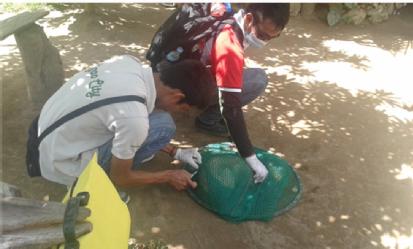Rabies
Rabies is a vaccine-preventable viral infection that causes approximately 59,000 human deaths annually. Every year, over 50,000 people die from rabies, whilst around 15 million receive post-exposure prophylaxis as a result of exposure to the disease, posing a significant threat and economic burden to public health. Although distributed throughout much of the world, the majority of human cases occur in Africa and Asia, and predominantly in children younger than 15 years. Due to this high prevalence among children, rabies is estimated to cause more than 2 million disability-adjusted life years (DALYs) per year, which results in an annual economic burden of more than $4 billion (US). Despite these alarming figures, rabies is still regarded as a neglected zoonotic disease and there are significant levels of under-reporting of the disease.
All mammals can be infected by rabies; however, domestic dogs are responsible for >99% of human cases and in most countries represent the principle reservoir host. Humans cases are contracted through bites from infected animals, but appropriate post-exposure prophylaxis (PEP) can effectively prevent human deaths caused by rabies infection, provided the vaccine is administered in timely manner following WHO guidelines. PEP is, however, extremally costly and in global shortage, and PEP alone does not affect transmission of rabies in the source population. Mass dog vaccination has been the foundation for successful elimination of rabies from dogs in North America, western Europe, Japan and many areas in South America. However, in low- and middle-income countries (LIMICs) in Africa and Asia canine rabies remains widespread and vaccination of dogs is typically not carried out at the levels required to achieve elimination. Additionally, the under-reporting of rabies in dogs represents a challenge and it is crucial for surveillance programmes to be implemented to identify rabid dogs in the community in order to minimise the future human health risk of the disease.
Rabies in the Philippines – the BITERS project
 Researchers at the University of Warwick (Dr Mike Tildesley and Kristyna Rysava) have been working on the development of an enhanced surveillance project in the Philippines since 2017 in collaboration with the Bureau of Animal Industry (BAI), the Albay Veterinary Office (AVO) and the World Organisation for Animal Health (OIE). The project has been implemented in animal bite treatment centres (ABTCs) throughout Albay province and is underpinned by the development and implementation of an integrated, intersectoral surveillance scheme to consolidate human and animal health sectors to guide field investigations in response to animal bite incidents presented at anti-rabies clinics.
Researchers at the University of Warwick (Dr Mike Tildesley and Kristyna Rysava) have been working on the development of an enhanced surveillance project in the Philippines since 2017 in collaboration with the Bureau of Animal Industry (BAI), the Albay Veterinary Office (AVO) and the World Organisation for Animal Health (OIE). The project has been implemented in animal bite treatment centres (ABTCs) throughout Albay province and is underpinned by the development and implementation of an integrated, intersectoral surveillance scheme to consolidate human and animal health sectors to guide field investigations in response to animal bite incidents presented at anti-rabies clinics.

Epidemiological questionnaires are recorded using a tailored android application (the Bite Incidence Tool for Enhanced Rabies Surveillance - BITERS) at ABTCs to document bite cases. Suspect cases are followed in the community and reported to veterinary services to reduce overall rabies incidence through biosecurity measures such as dog quarantine and movement restrictions). Since the establishment of our integrated surveillance scheme in Albay province in early 2018, we have overseen a significant increase in the number of detected, laboratory confirmed dog cases, directly yielding positive public health implications. The data accrued from animal bite incidents and resultant field investigations are currently being used in the development of a mathematical model to investigate the optimal intervention and surveillance measures that can be implemented to reduce the impact of rabies in the province in the future, ultimately achieving and sustaining freedom from the disease.
Rabies in Indonesia – battling rabies on Bali

The first suspected human case of rabies in Bali was a four-year-old child in September 2008 by which point substantial secondary transmission had been already established in the dog population. Initial control strategies involved localised culling of dogs, as well as targeted vaccination in the affected peninsula. Repeated mass vaccination campaigns of dogs were introduced on the island in late 2010 followed by integrated bite case management (IBCM) in late 2011. A change in control strategies caused a resurgence of cases in 2015, but intensified vaccination campaigns following the second outbreak resulted in a re-establishment of the progression of

the island towards elimination. More than 10 years of data have been collected to this date, providing a unique opportunity to trace dynamical transitions of rabies in an island setting spanning from a single case incursion through to near-elimination dynamics with multiple meanders along the way. Using this unique data set, the University of Warwick team has been developing a biologically and ecologically informed mathematical model to capture the complex largely heterogeneous nature of rabies dynamics, yet universal enough to offer generalizable results across settings and straightforward guidance to evaluate and ensure progress towards elimination targets.
Funded by: BBSRC, EPSRC
SBIDER people involved
Mike Tildesley
Isty Rysava
External collaborators
Katie Hampson (University of Glasgow)
Florencio Adonay (Albay Veterinary Office, the Philippines)
Rona Bernales (Department of Agriculture, the Philippines)
